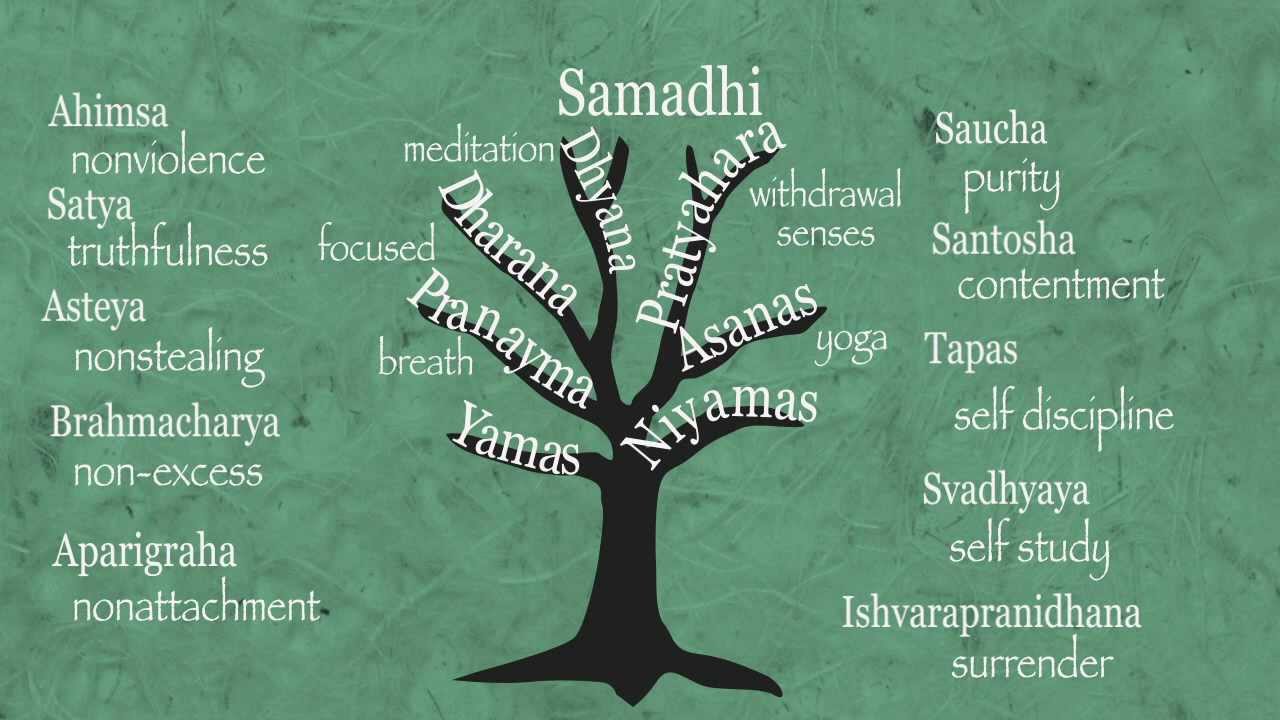
In his book, The Master and his Emmissary, Dr. Ian McGilchrist takes the reader through how the structural differences in attention of the left and right brain affect individual and societal perception and behavior.
Illustrating in allegory and story what McGilchrists research and work of 20 years conveys, the Yoga Sutras describe 3 different perceptual experiences that belong to the 8 branches of Yoga. They are Dharana, Dhyana and Samadhi. These three forms of perception appear to be describing the same phenomenon of left/right lateralization described by McGilchrist as well as the ego dissolving attention found in the modern definition of Flow.
McGilchrist and research on the phenomenon of Flow echos what the Yogic texts have observed and what modern neuroscience proves – that the optimal state of existence is derived from a perception that is both detailed and expansive. A vision that grants the capacity to comprehend and experience total independence as well as all inclusive connection.
Left vs. Right Brain Lateralization: Focused (Dharana) vs. Global (Dhyana) attention
Dharana develops and sharpens intelligence, dhyana purifies consciousness and samadhi leads consciousness towards the soul. (3.7 Patanjali Sutras B.K.S. Iyengar)
It appears that our ability to pay attention to the opposing and complimentary perceptions offered by the meditative practices of Dharana and Dhyana are built right into the asymmetrical structure of our brain. McGilchrist explains that generally speaking the main differences between the two hemispheres of the brain is not what they do, but HOW they do it. Their differences exist in their attention and resulting perception – not tasks or actions.
VERY broadly speaking one could say that the left brain attends to details and is drawn to the familiar. It views reality as a composition of separate distinct parts pieced together. In contrast, the right brain is drawn to the unfamiliar and takes on a more global perspective. Rather than putting pieces and parts together, it observes the whole and then figures out how the parts fit into it.
Dhāraṇā धारणा – The Elephant Tail
Dharana is often referred to as the initial step of deep concentrative meditation. In the 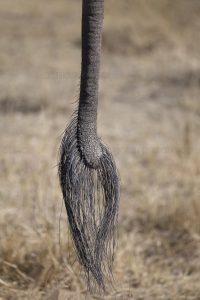 Yoga Sutras of Patanjali , the practice of Dharana implies fixing one’s mind on an object of meditation. It can be translated as single-pointed concentration and focus. In practice the mind thinks about one object and avoids other thoughts.
Yoga Sutras of Patanjali , the practice of Dharana implies fixing one’s mind on an object of meditation. It can be translated as single-pointed concentration and focus. In practice the mind thinks about one object and avoids other thoughts.
The Indian philosopher and theologian Adi Shankara gives the example that contemplating on the sun’s orbit alone, without being interrupted by its color, brilliance or other related ideas is an example of Dharana. Another more terrestrial example, and one I will refer to throughout this blog, would be the deep contemplation of the texture, color, form and composition of an elephants tail while disregarding the rest of the elephant completely.
Left Brain Attention and Dharana
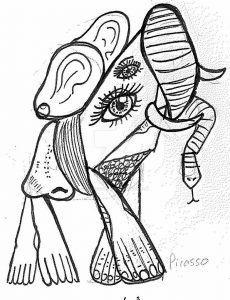 The left brain is what enables us to focus in on the details and mechanics of reality. For instance, a bird who is out searching for food uses the right eye (left hemisphere) to pick out a worm or piece of grain from gravel. The left brain is also what allows us to express and explore our reality through the EXPLICIT tool of spoken and written language. It is associated with the neurotransmitter dopamine and therefore addiction, as well as the drive for security, grasping and consumption. It is strongly associated with the experience of anger and is reduced in its capacity to see peripherally and is generally´blind´to unfamiliar experiences and concepts. This makes it excellent at completing tasks and exploring the detailed mechanics of how something works. However, without the global context offered by the right hemisphere, the selective and detailed attention of the left brain can skew the perception of reality. For example, to make sense of the image of an elephant, the left hemisphere would take bits and pieces of the elephant and quilt them together into something that might look much more like a Picasso abstract painting rather than a living, breathing, elephant.
The left brain is what enables us to focus in on the details and mechanics of reality. For instance, a bird who is out searching for food uses the right eye (left hemisphere) to pick out a worm or piece of grain from gravel. The left brain is also what allows us to express and explore our reality through the EXPLICIT tool of spoken and written language. It is associated with the neurotransmitter dopamine and therefore addiction, as well as the drive for security, grasping and consumption. It is strongly associated with the experience of anger and is reduced in its capacity to see peripherally and is generally´blind´to unfamiliar experiences and concepts. This makes it excellent at completing tasks and exploring the detailed mechanics of how something works. However, without the global context offered by the right hemisphere, the selective and detailed attention of the left brain can skew the perception of reality. For example, to make sense of the image of an elephant, the left hemisphere would take bits and pieces of the elephant and quilt them together into something that might look much more like a Picasso abstract painting rather than a living, breathing, elephant.
In the practice of Yoga Asana, the detailed activity of the left brain (Dharana) is activated as we explore the mechanical architecture of the asana form. For instance, the detailed attention of the foot and how it is affected by the physical placement of the toes and heel to lift the arch would be an act of Dharana. Taking that mechanical observation into sensory perception and noticing how it affects the placement of the spine and the whole felt experience of the body, breath and mind would be entering into the practice of Dhyana – where greater activation of the right brain begins to takes place.
Dhyāna ध्यान – The Whole Elephant
Dhyana is associated with the goddess Saraswati, the powers of wisdom, music and poetic 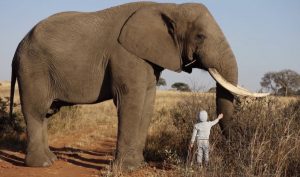 eloquence. It is defined as the practice of sustained, non-judgmental, non-presumptuous contemplation of a concept/idea in all its aspects, forms and consequences. It is the ablity to observe the color and brilliance of the sun as well as its orbit. It integrates the focused observation of the Elephants tail (Dharana) into the composition and experience of the entire elephant.
eloquence. It is defined as the practice of sustained, non-judgmental, non-presumptuous contemplation of a concept/idea in all its aspects, forms and consequences. It is the ablity to observe the color and brilliance of the sun as well as its orbit. It integrates the focused observation of the Elephants tail (Dharana) into the composition and experience of the entire elephant.
Right Brain and Dhyana
According to McGilchrist the right brain offers a more global perception and allows us to see reality as a whole rather than in parts. For example, a bird favors its right eye (left hemisphere) to pick out a piece of grain. However, it uses its left eye (right hemisphere) to maintain a awareness of the world around it. This global awareness helps to ensure that the bird is safe from outside threats while maintaining an awareness of a potential mate, as it pecks out food on the ground.
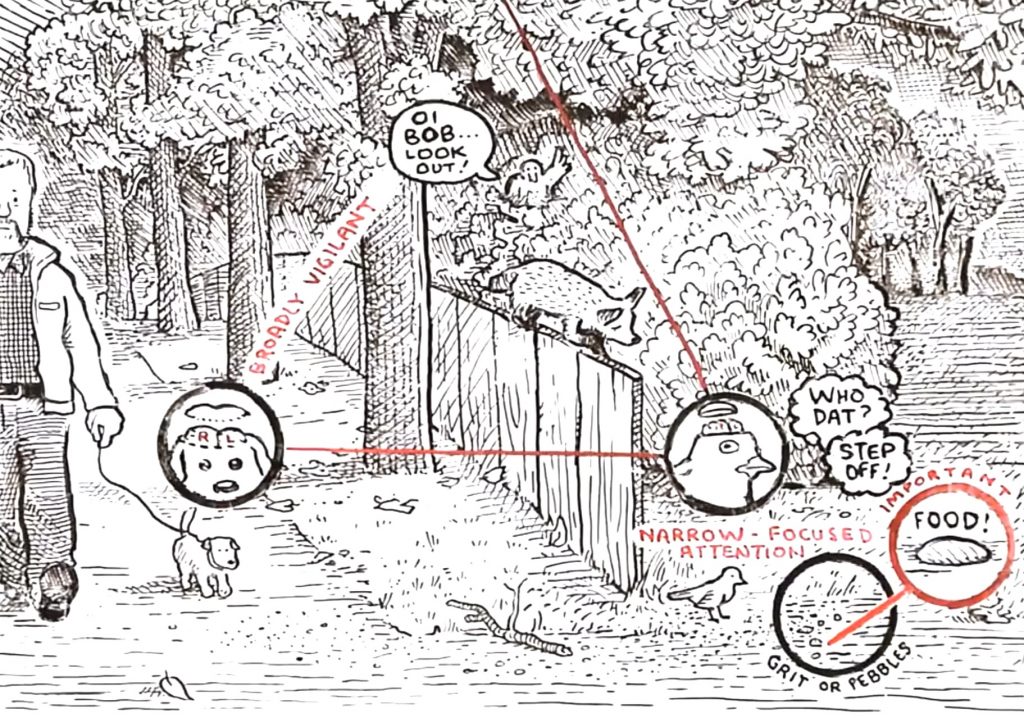
The right brain is associated with IMPLICIT communication and comprensión of reality as expressed through body language, music, art, poetry, story and dance. It is associated with the neurotransmitter norpenephrine and is responsible for ´the theory of mind´ – the capacity to ´feel another´s pain ´. This capacity to understand and perceive ´the other´ is developed right along with our capacity for self awareness. Those who suffer from autism and forms of schizophrenia often have damaged or reduced right brain activity. Furthermore, when looking at 3D, 2D and real life hand images, the right brain is only activated with the appearance of a real live hand.
In contrast to the focused and mechanical attention of the left brain, the right brain views reality as a whole, allowing new and periphal information to influence its global perception. In fact, even the capacity for peripheral vision (the capacity to see something outside of your direct vision) is controlled by the right hemisphere – even in the activity of the right eye – which is mechanically controlled by the left hemisphere. This ability to connect various pieces of information, including new, peripheral and even threatening information, is fundamental for communication, creativity and problem solving. Without the integral perception offered by the right brain, it would be impossible to effectively resolve complex issues or understand the implicit communication of human relations and experience.
In the practice of Yoga Asana, due the non-judgmental attention placed upon the internal sensorial experience of the body and breath, the right brain (Dhyana) is constantly activated. In the non-judgemental observation of sensory experience, explicit language disappears and the practicioner becomes one with the implicit experience of simply BEING in the pose. Essentially, this experience of being is when the ego and the sensation of the separation between the observer and the observed begins to disappear. B.K.S. Iyengar states that this experience of Dhyana is what flows into the sweet bliss of Samahdi, or as modern neuroscience might call it, Flow.
Samahdi
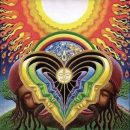 In the Tradition of Yoga, Samadhi has been defined as a state of total absorption that follows the internal practices of Dharana and Dhyana. It is a space of pure ecstasy and contemplation where the ego and sense of Self completely dissolve into Bhavana – a state of pure feeling and experiencing. In this state the practicioner directly perceives Truth and fully understands the Self as a connected and eternal expression of the Divine.
In the Tradition of Yoga, Samadhi has been defined as a state of total absorption that follows the internal practices of Dharana and Dhyana. It is a space of pure ecstasy and contemplation where the ego and sense of Self completely dissolve into Bhavana – a state of pure feeling and experiencing. In this state the practicioner directly perceives Truth and fully understands the Self as a connected and eternal expression of the Divine.
Flow
According to original Flow researcher Csikszentmihalyi and author Steve Kotler, Flow is a state of deep absorption and concentration where action and awareness merge into one. Self awareness disappears as a person experiencing Flow perceives themselves as not separate from their object of focus. This deeply connected sense of concentration is what enables individuals to function at their optimal capacity, fine tune their perception, tackle challenging endeavors with ease and at the same time experience an éxtasis of being.
Samahdi, Flow and full brain activation
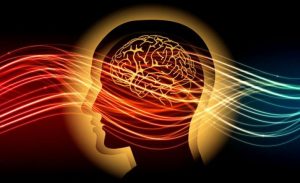
On a structural level it has been found in neuroimaging studies that there is bilateral activation of the brain (left and right hemispheres) in states of Flow AND deep meditation which are associated with the above descriptions of the dissolved self disappearing into a state of complete connection and timeless bliss (Ulrich et al., 2014.,Heinzel et al., 2017; Sokolowski et al., 2017).
In both definition and structural activation of the brain, Flow and Samahdi appear to be defining the same states of awareness. The great teacher BKS Iyengar states that indeed musicians, inventors, artists etc. experience a state of Samahdi when they find themselves completely immersed in their art. However, he clarifies that the difference between this state of Samahdi, or Flow, experienced by the artist rather than that of the Yogi, is that it is temporary. For the artist the state of blissful non-ego existence is connected to their external work. For the Yogi, the state of Flow/Samahdi is not temporary because it arises from the internal practice of concentration, totally independent of external sources or action. The discipline of Yoga and psychology have observed that this independence is key to experiencing the joy of Being .
Optimal Perception and Being
To comprehend the nature of existence one must open their perception beyond the mechanical left brain. To comprehend reality,the left brain explicit language of textbooks and peer reviewed journals must include the implicit right brain territory of allegory, music, poetry and story. The inteligente of the left brain must be interpreted through the consciousness of the right brain. To understand the purpose of the elephant tail, one must be able to perceive the entire elephant, its environment and evolutionary history.
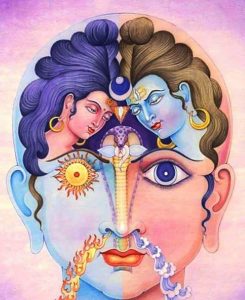 Without the inclusion of both forms of attention (detailed/mechanical and global/emotional), the perception of reality is limited and senseless. After all, without the context of the elephant and the world around it, would you be able to identify, let alone define, the purpose of an elephants tail? Without placing the elephants tail into the greater context of the entire elephant, it is just a piece of skin and bone void of purpose. It is in the act of both detailed and expansive observation that we can begin to perceive the awe inspiring miracle of creation. This act of combining Dharana and Dhyana into the all inclusive, self-dissolving, Samahdi attention is what transforms the isolating ego-centric vision of the Self in to the perception of limitless connection and freedom.
Without the inclusion of both forms of attention (detailed/mechanical and global/emotional), the perception of reality is limited and senseless. After all, without the context of the elephant and the world around it, would you be able to identify, let alone define, the purpose of an elephants tail? Without placing the elephants tail into the greater context of the entire elephant, it is just a piece of skin and bone void of purpose. It is in the act of both detailed and expansive observation that we can begin to perceive the awe inspiring miracle of creation. This act of combining Dharana and Dhyana into the all inclusive, self-dissolving, Samahdi attention is what transforms the isolating ego-centric vision of the Self in to the perception of limitless connection and freedom.
As explored in previous blog posts, it is this perception of freedom that determines an individuals overall state of wellbeing . The 8 limbs of Yoga simply provide rituals and practices (Yamas, Niyamas, Pratyhara, Asana, Pranayama, Dharana, Dhyana, Samahdi) that effect the various layers of existence in order to balance the structure and system of that great perceiving machine – the brain. By increasing and amplifying our perception of existence we increase our capacity to problem solve and connect with the world around us and WITHIN us. This amplified perception of existence can help us to let go of the the fear of death and enable us to release the need to grasp onto what is safe and familiar so that we can be free. Free to explore and experience the limitless sensations of existence that this present moment offers us.

